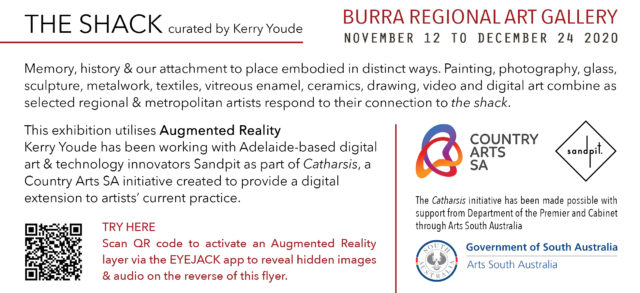The Shack – November 14 to December 24 2020
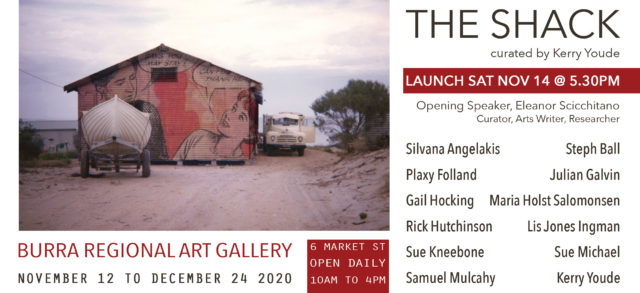
Painting, photography, sculpture, prints, glass, metalwork, vitreous enamel, ceramics, drawing, video, digital art and augmented reality combine as selected regional and metropolitan artists respond to their connection to ‘the shack’, its environment and history.
The Shack is currently showing at Burra Regional Art Gallery until Sunday 24 December. The exhibition takes the form of an archival collaboration of cultural creativity by 12 artists, curated and including works by Burra artist Kerry Youde. It features augmented reality pieces by Kerry, giving it a depth of meaning and furthering viewers’ understanding of the project. Kerry’s AR skills have been developed with the assistance of Adelaide-based digital art and technology innovators Sandpit as part of ‘Catharsis’– a Country Arts SA initiative created to provide a digital extension to regional artists’ current practice. ‘Catharsis’ has been made possible with support from Department of the Premier and Cabinet through Arts South Australia.
‘The Shack’ of the title started life as nurses’ quarters at Mallala Aerodrome during WW2. It was purchased at the clearing sale by Kerry’s great grandfather, cut in half and moved on two large trucks where it was rejoined at Black Point on Yorke Peninsula in 1961. Existing in memory and artefact, the shack combines history and an architecture of dramatic shape when seen from the beach, dark against the sky. Sited on the foreshore rise and surrounded by expensive homes, it is burdened by the now shortened lifespan of mid 20th century beachside holiday dwellings. These works are nostalgic, bringing back childhood memories – precious and never forgotten like a scent on the breeze or a favourite tune.
Many of the contributing artists have visited and made work that reflects their attitudes and emotions towards the beach shack environment and culture of a significant era in our post war story. They are Silvana Angelakis (Adelaide), Plaxy Folland (Curramulka), Gail Hocking (Sellicks Beach), Rick Hutchinson (Edithburgh), Sue Kneebone (Henley Beach), Samuel Mulcahy (Clayton Bay), Steph Ball (Warooka), Julian Galvin (Aldinga Beach), Maria Holst Salomonsen (Penwortham), Lis Jones Ingman (Burra), Sue Michael (Prospect), and Kerry Youde (Burra).
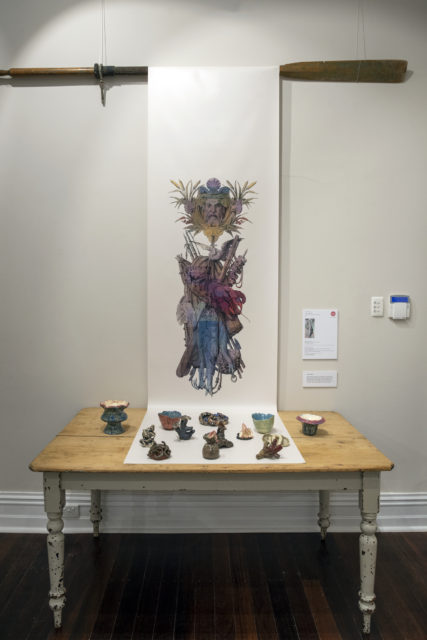
Kerry Youde and Lis Jones Ingman: Catch of the Day – Digital Collage, Fired Clay, Table and Boat Oar
The shack purchased in 1961 by my Great Grandfather was the RAAF Nurse barracks with the hospital adjacent. Due to its size it was split in half and transported on two trucks to where it became a holiday home for my family at Black Point, Yorke Peninsula. Growing up it was one of the larger places but still a ’shack’ with long drop toilet outside and the precious resource of rainwater water only available cold. As time moved on many of the older shacks were replaced with large holiday homes, the demographic and feel was in flux. In the mid 2000’s we would arrive to minor vandalism/trespass mainly by exploring children, unfortunately this escalated to the point where valuables ranging from large tables to period light fittings were stolen. Windows smashed, birds found a new home…all quite depressing, a place I had become accustomed to spending valued time with family and friends appeared lost.
A visit during my residency at ACE Open 2018 with Sue Kneebone was the start of a new optimism for its future. Trashed but beautiful, now possibilities of rehabilitation begin with this exhibition. – Kerry Youde
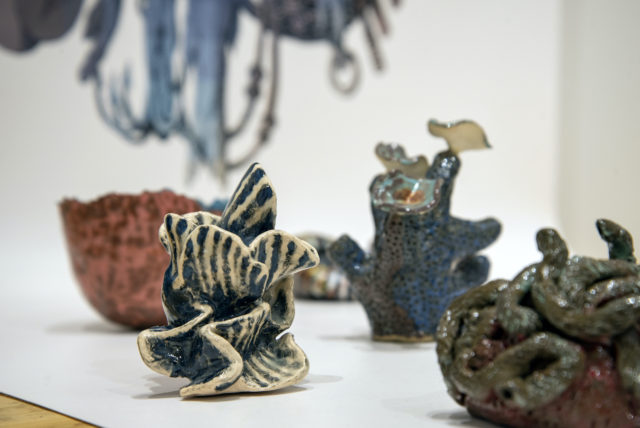
Lis Jones Ingman: Catch of the Day – Fired Clay Installation, detail
Rumble, stumble, tumble, grumble – love those words – and they fit with the delicacy (not) of these clay pieces. They are rough and tough, they talk to you about things imperfect but with (I hope) a gut-wrenching credibility. Life forms make themselves out of what’s available – “to hand” you could say, and hands are key. Clay is chosen, with glass and fire, and then, with the passing of a day and a night, a breath-holding element of surprised recognition. – Lis Jones Ingman
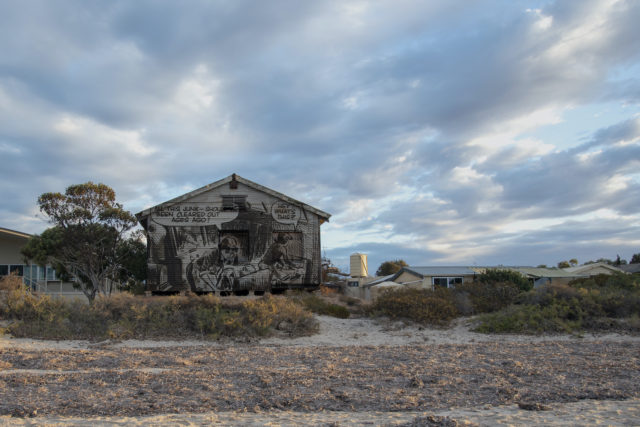
Kerry Youde: All this Junk – Digital Collage
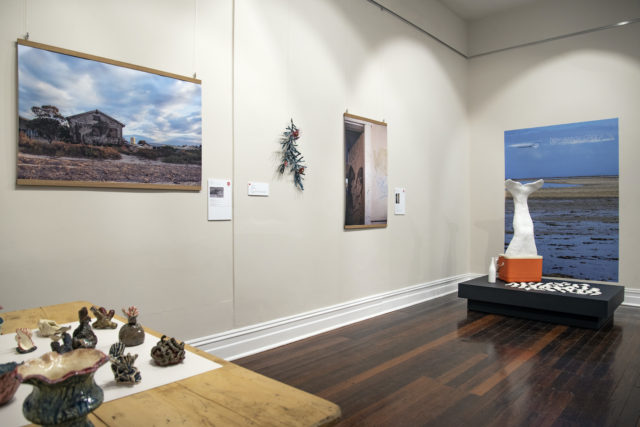
The Shack – Main Gallery
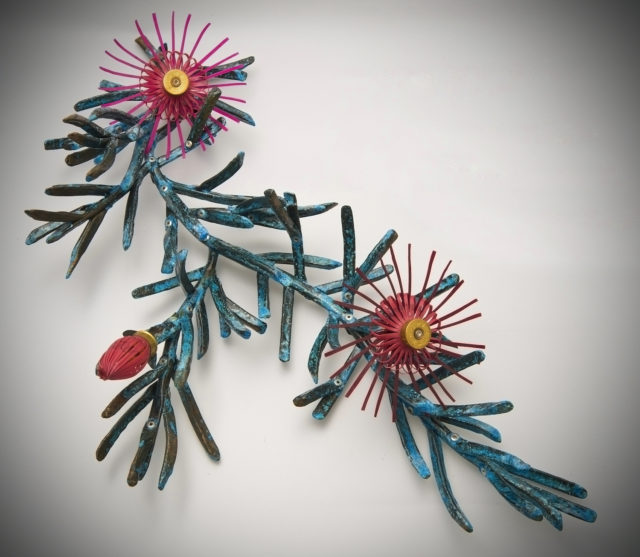
Samuel Mulcahy: Tetnesteii Virscense – Copper and Shotgun shells SOLD
photo credit Richard Hodges
The shack stands on this land through loving family times and through darker silent spells. The relics of flora survive on the periphery patiently waiting to reclaim their place. – Sam Mulcahy
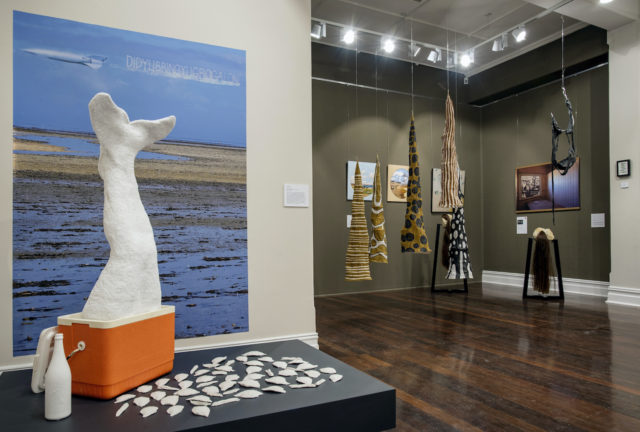
Sue Kneebone: LINGA LONGA, 2020 – Esky, plaster, terry towelling, adhesive wall print
Along the northern shorelines of the Gulf St Vincent lies Parham, a small coastal town in the district of Mallala fringing on the delicate ecology of samphire swamps, intertidal mudflats, shell grit shores and remnant mangroves. Parham itself was once threatened with ‘extinction’ in the early 1980s by the Australian Army who wanted to expand its neighbouring weapons testing ground. Although the locals won the fight for Parham to remain, munitions testing continues offshore and out of sight as indicated in prohibition zones mapped on signs at Parham’s boat ramp. My work seeks to highlight the incongruity of this unsettling presence in the vicinity of holiday shacks whose personalities are expressed by their owners with cheeky names such as ‘didubringyugrogalong’ and ‘Linga Longa’ displayed on makeshift signs that look out to the occasional crabber seen as a speck on the horizon line between the tidal mudflats and sky. – Sue Kneebone
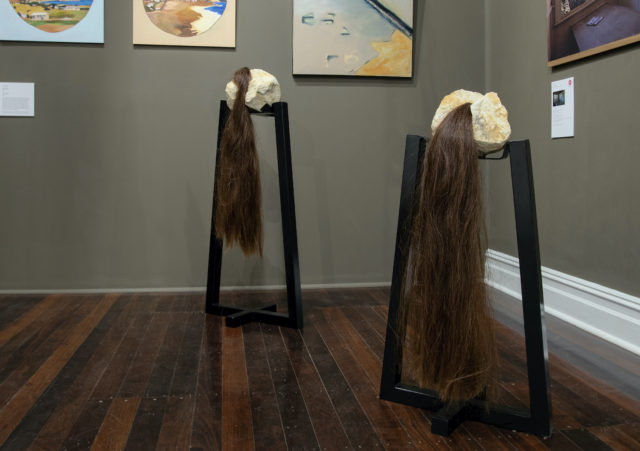
Gail Hocking: HOLD I – Sandstone, hair fibres, steel $750
HOLD II – Sandstone, hair fibres, steel $850
‘Most of our life is a series of images that pass us by like towns on a highway. Sometimes a moment stuns us as it happens – and we know that this instant is more than a fleeting image – we know that this moment every part of it will live on forever.’ Miroslaw Balka
These new works navigate personal ‘Bach’ memories from home (Aotearoa). Fishhooks, sandstone, lures are objects that generate a recall of the intensity of these moments. – Gail Hocking
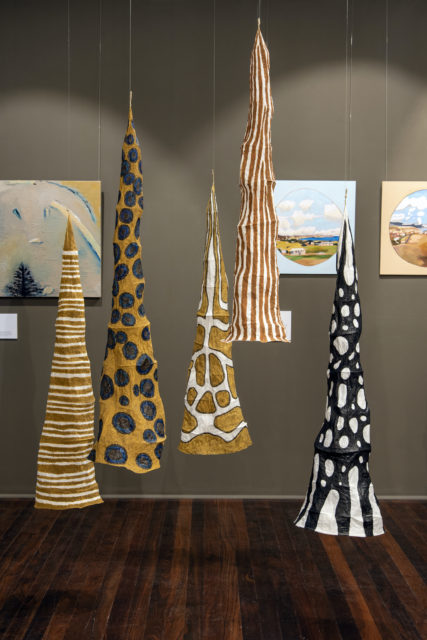
Maria Holst Salomonsen: Fish Traps – Paper, reeds, clay & ink – Installation of 5 $1850
The use of traps to catch fish has a long history. Around the world, people have designed and made these traps throughout history, using different materials and shapes, dictated by the resources and fish available in the area. There are two types of trap, a permanent or semi-permanent structure placed in a river or tidal area and a more permanent type. The traps that the Narrunga/Adjahdura people, living at Black Point used, are of the more permanent type, constructed out of rocks. Remnants of these can still be seen along the coastline.
My traps are constructed from split and dried reeds, they make up the ‘skeleton’. This construction is covered with several layers of thin paper, held together with a wheat paste. Clay, collected from my Clare Valley property, sumi-e ink, which is made from soot and burned wood, a handmade brown ink, from walnut hulls and a blue writing ink, decorates each trap with a different pattern. The patterns are inspired by sea creatures. Featured are Blue Ringed Octopus, Pyjama Striped Squid, Larger Pacific Striped Octopus, Fiddler Ray and Mimic Octopus.
As long back as the Vikings, Ochre has been used, not only for decorating their long houses, but also in colouring the rune stones, which are known mostly around Scandinavia, but also from places around Europe where the Norsemen visited during the Viking age. The most common paints were red ochre, red lead, soot, calcium carbonate, and other earth colours, which were bound with fat and water. The use of these colours continues in todays’ Norway and are very much a part of my memories of family visits and holidays over the years.
Traditionally Norwegian houses were painted a strong red, yellow, or white. White is the most popular colour. The colour the owners chose depended mostly on the family’s financial situation, geographic location and profession. Certain colours required certain resources, therefore some colours cost more or less depending on the availability and access of the various resources needed to make these paints.
I have a deep respect for Indigenous cultures, connection to the land is important to me, using natural materials strengthening this spiritual belonging with my work referencing shared links to my cultural heritage. – Maria Holst Salomonsen
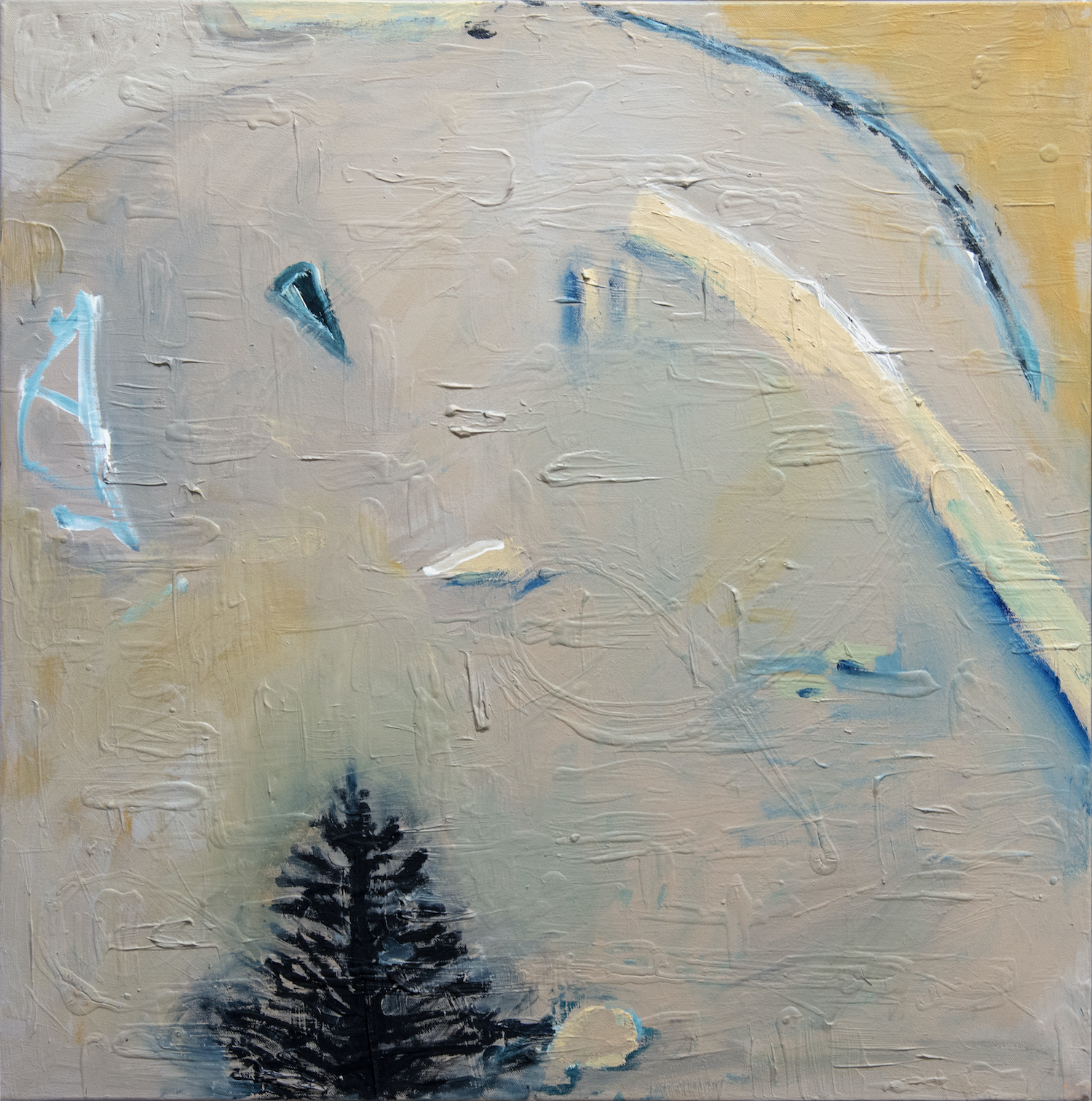
Silvana Angelakis: Out to Sea – Acrylic Mixed Media $600
Even though I graduated from art school as a painter, for the last 20 years printmaking and sculpture has been my medium of choice, requiring considered thought and process. I wanted the immediacy of acrylic paint to capture the moody still vistas that looking out across the sea at different points on the Yorke peninsula punctuated with bits of activity. – Silvana Angelakis
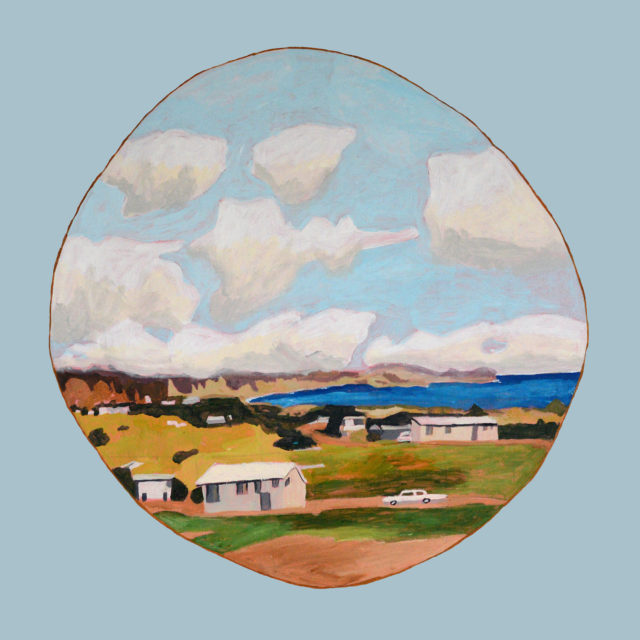
Dr Sue Michael: Cloud Puff Bay – Acrylic on board $800
The larger paintings are part of a collection Sue began to locate a sort of ‘lost world’, so they could take their place in our current society through the use of fabrics for interiors. These larger paintings are the patterns for her fabric, now. They are scenes from a stranger’s 35mm slides from the 1960’s, of Sellick’s Beach. People seemed to provide more space for the natural elements of the landscape, and any shack’s accommodation would have space between each building. Perhaps we had no fly screens and no air conditioning in those days, but this allowed a closer interface with the natural world. Sue often daydreams of her ear on the wet sand, listening to the thundering surf, with sand on her eyebrows, baking warmth on her back, and ‘pruned’ hands from endless water frolicking.
She thinks her task is not to be sentimental, but to reassess those enduring elements of place that are still so meaningful and still require our attention. – Dr Sue Michael
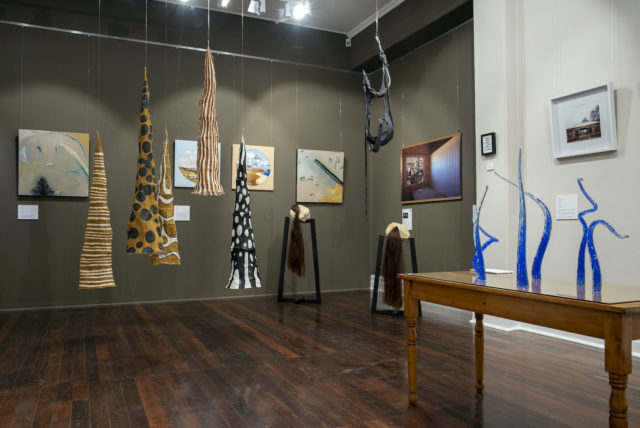
The Shack – Main Gallery
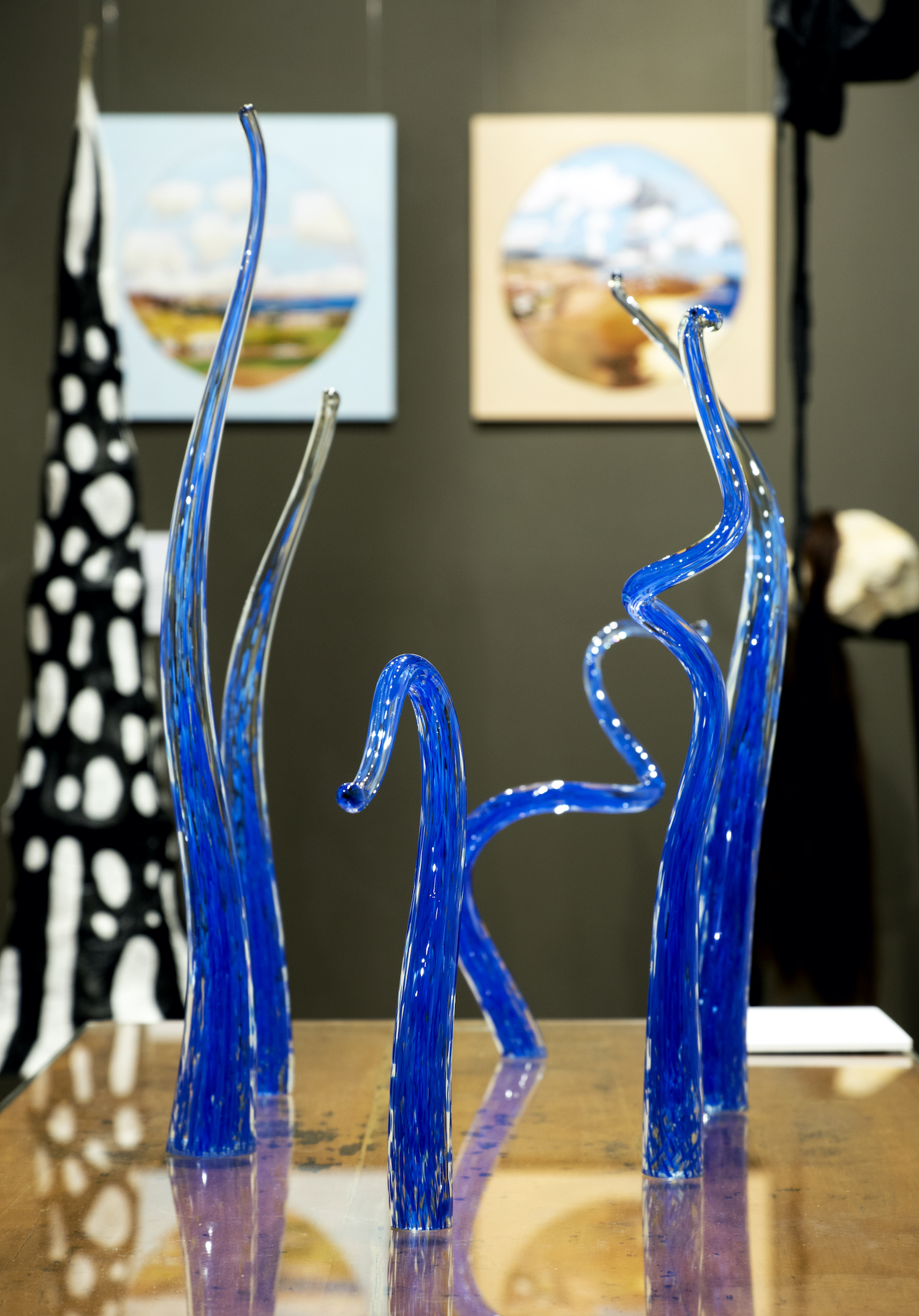
Julian Galvin: Invaders of Space – Glass – Installation of 6 $750
Invaders of Space is a 6-piece solid sculpture made from clear and coloured furnace glass. Through this work I seek to bring our surroundings to the forefront of our mind, creating a conscious awareness of the space we occupy and how we interact within it. The combination of precarious forms with a fragile material gives my work both a commanding presence within the space it occupies, and a creeping sense of anxiety within the viewers that share that space. – Julian Galvin
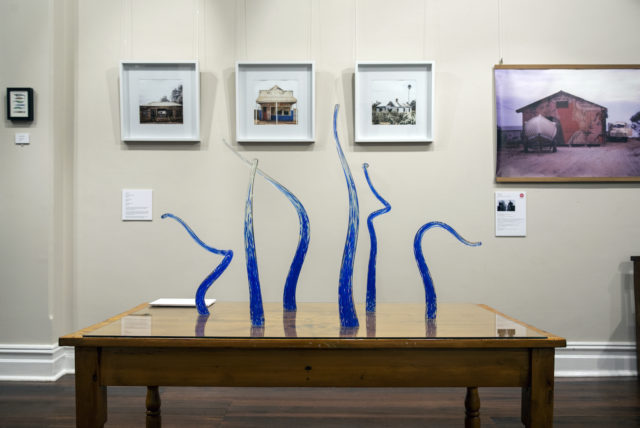
Julian Galvin: Glass, Steph Ball: Photography, Kerry Youde: Digital Collage
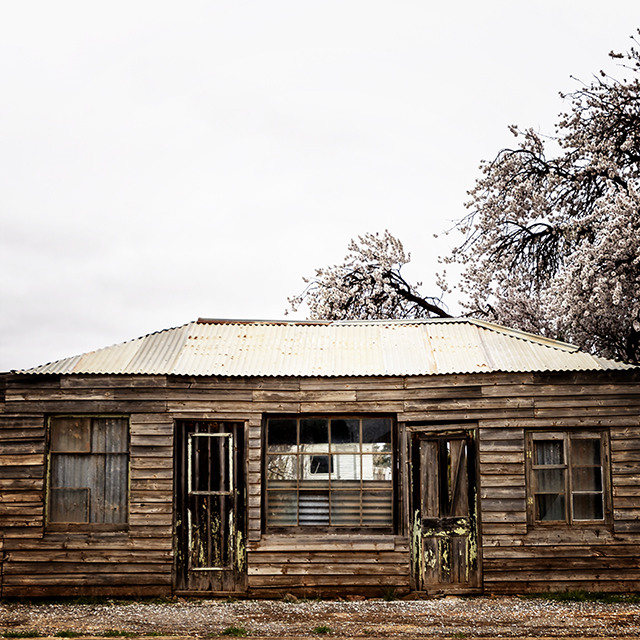
Steph Ball: WEATHER BOARD ‘SHACK’ – Photography $165
When invited to be a part of Kerry’s exhibition ‘The Shack’ my thoughts were immediately taken back to childhood summers spent with crayfishing Godparents at Pondalowie Bay.
These are very special memories of fishing trips on the old cutter ‘The Ellen’, lots of beach time, seashell hunts, playing cricket in the ‘street’, and running barefoot through the scrubby sandhills with their black labrador King, and never any thought of snakes!
Maybe it was those old shacks that instilled an enthusiasm to hunt out and photograph old abandoned buildings, now a favourite pastime! – Kerry Youde
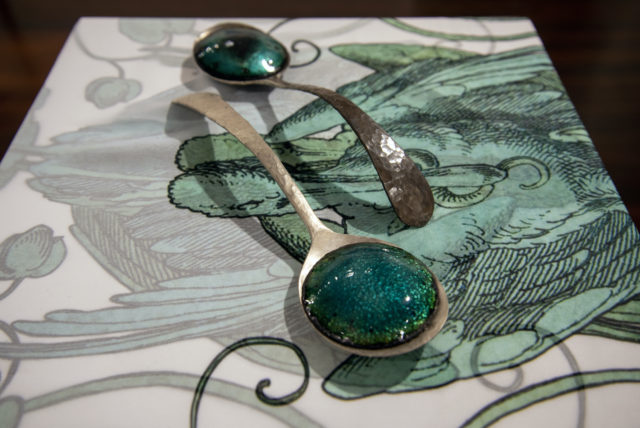
Kerry Youde: There be Monsters – Printed textile, Nickel Silver and Vitreous Enamel on Copper
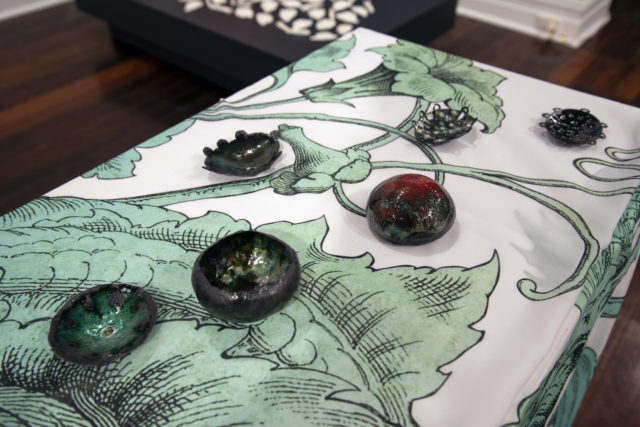
Kerry Youde: There be Monsters – Printed textile and Vitreous Enamel on Copper
Memories of childhood fears and an imagination run rampant combine. The sea is dark and mysterious, unknown creatures patiently lurk beneath the waves. In the coastal scrub scaled dangers for the unwary. Cautionary tales told to protect embedded in our collective psyche…BEWARE – Kerry Youde
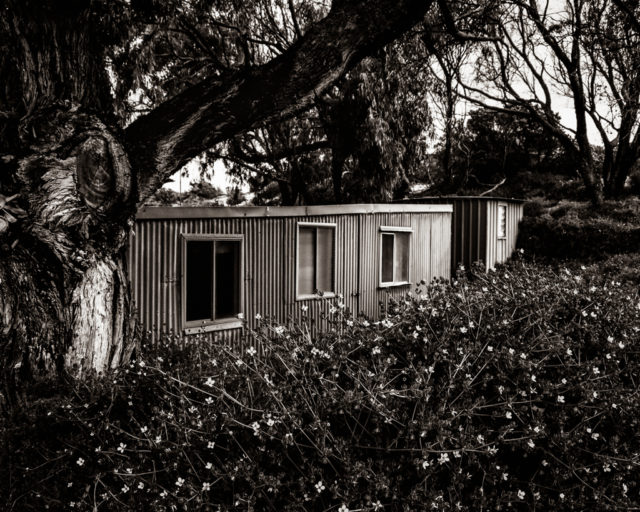
Steph Ball: Pondi Shack #1 – Photography $140
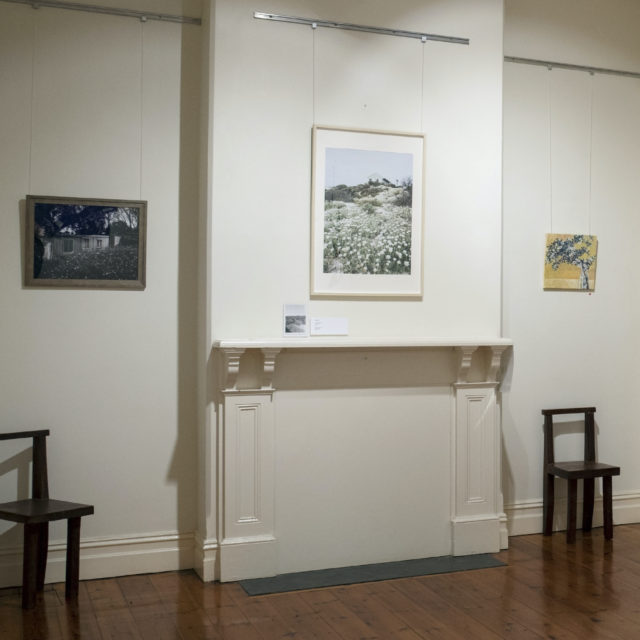
Steph Ball: Photography / Plaxy Folland: Oil on Canvas
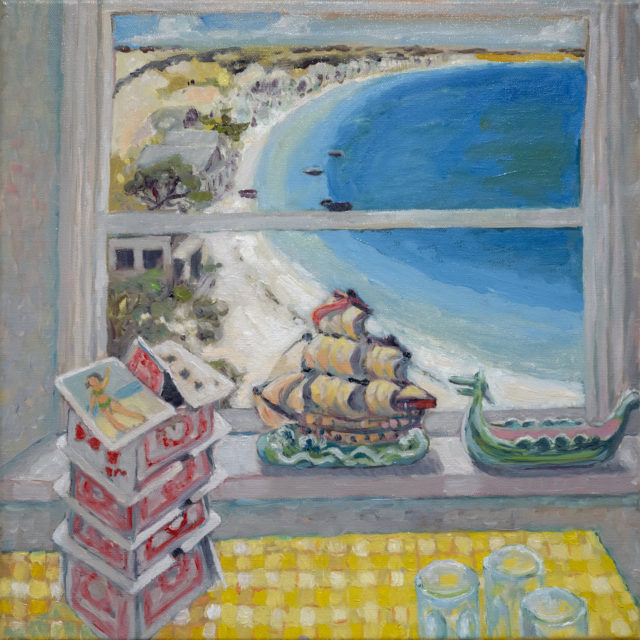
Plaxy Folland: The dreaming past oil on canvas SOLD
my work is usually observational and a little playful.
i like to make connections between familiar objects and memory or story.
here’s a story
the shack,
like a long boat
perfectly positioned to launch us into the silver bay
and into a stretch of time
of games and gathering
and constant urn-ing,
of shouts and calling
and dreaming quiet
our skin is burnished
by the elements,
we are offered crab sandwiches
but prefer vegemite on saos.
our xmas treasures
we carry to the desert island,
golden horses and story books.
adrift, marooned
until the unwelcome
idea of february intrudes – Plaxy Folland
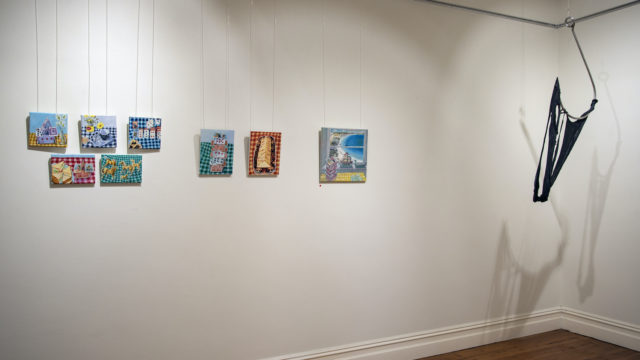
Plaxy Folland: Acrylic on Linen, Acrylic on Board and Oil on Canvas
Gail Hocking: SNAG-Residue of a moment – Polished stainless steel, cement, muslin
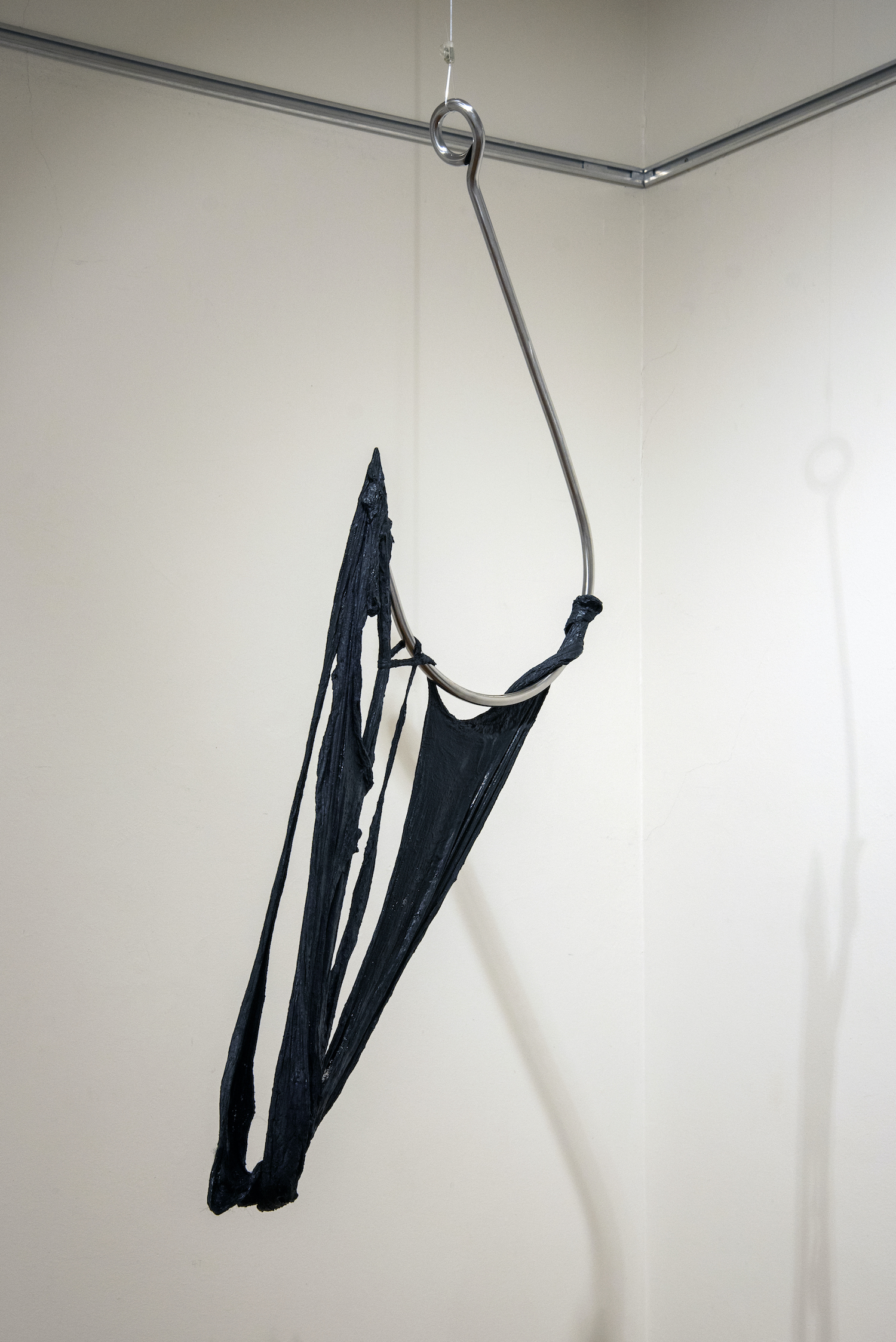
Gail Hocking: SNAG – Residue of a moment – Polished stainless steel, cement, muslin
1 of an installation of 3 $3500
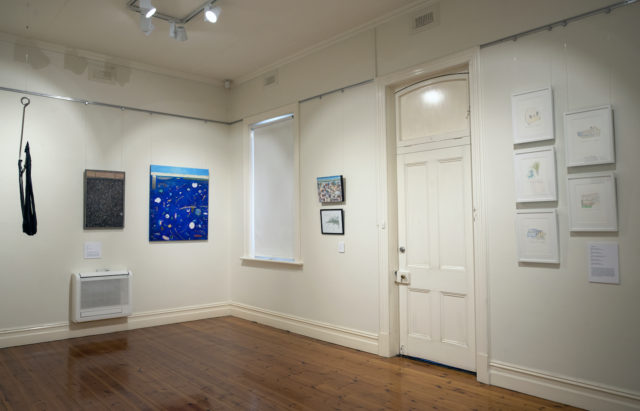
Bence Room – Gail Hocking, Rick Hutchinson and Sue Michael
Pencil sketches from a walk along the beach at Black Point. Each shack seems to have its own selective resources, viewing platforms, and sites of particular activities. For instance, a small boat nestles near the hardy shrubs at the base of one shack’s steps. On closer inspections there are fastened, small wheels that have been added to the underside of this boat. It is a practical, vernacular, adaption, designed and perhaps manufactured by the owner, themselves. It may be upon closer observations that we can grasp elements of geographic thought, where we see how locals meld to the environmental conditions, rather than strive to overtake them. – Dr Sue Michael
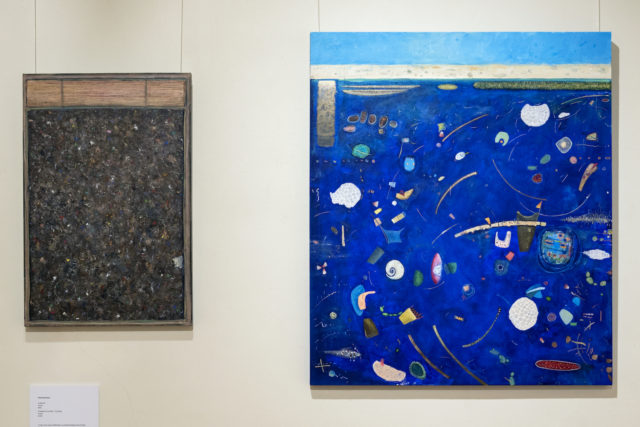
Rick Hutchinson: Comfort – Acrylic $300 and Evidence of Water, Floating – Acrylic $1200
Living on the coast at Edithburgh is a rewarding pleasure and privilege.
The Shack is a symbol of people wanting to be part of the environment, the conjuncture of land and sea (water).
My art is multi faceted, driven by visual responses, memories and impulses which is based around this conjuncture. Colour is a key element along with experimentation with different ideas, concepts and techniques. Application of paint and the process of abstraction are key elements also. I enjoy the act of creating and working with different media to express my individuality as an artist. – Rick Hutchinson
